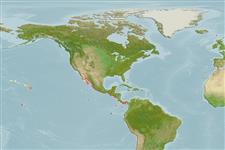>
Eupercaria/misc (Various families in series Eupercaria) >
Haemulidae (Grunts) > Haemulinae
Etymology: Haemulon: Greek, haimaleos = bloody (Ref. 45335).
More on author: Gill.
Environment: milieu / climate zone / depth range / distribution range
Ecología
marino asociado a arrecife. Tropical; 38°N - 4°N
Eastern Pacific: Baja California, Mexico to Colombia.
Tamaño / Peso / Age
Maturity: Lm ? range ? - ? cm
Max length : 30.0 cm TL macho / no sexado; (Ref. 9114); common length : 25.0 cm TL macho / no sexado; (Ref. 9114); peso máximo publicado: 557.00 g (Ref. 40926)
Body oblong, compressed, and deep (depth contained 2.2 to 2.7 times in standard length); mouth large and terminal, its posterior end located at the same level as the anterior edge of the pupil; first gill arch with 22 to 39 gill rakers; dorsal fin notched, with 12 to 14 spines and 14 to 17 soft rays (XII-XIV, 14-17); second anal spine slightly longer and stronger than third; scale series above lateral line is parallel to it; body dark brown; each scale bearing a pearly blue spot, the spots appearing to form lines following the scale series; fins yellowish; caudal peduncle with a large spot (Ref. 55763).
Found in schools around coastal reefs during the day, dispersing over sandy bottoms at night (Ref. 9114). Marketed fresh (Ref. 9114).
Life cycle and mating behavior
Madurez | Reproducción | Puesta | Huevos | Fecundidad | Larva
Oviparous, distinct pairing during breeding (Ref. 205).
McKay, R.J. and M. Schneider, 1995. Haemulidae. Burros, corocoros, chulas, gallinazos, roncos. p. 1136-1173. In W. Fischer, F. Krupp, W. Schneider, C. Sommer, K.E. Carpenter and V. Niem (eds.) Guia FAO para Identification de Especies para lo Fines de la Pesca. Pacifico Centro-Oriental. 3 Vols. FAO, Rome. (Ref. 9114)
IUCN Red List Status (Ref. 130435)
Threat to humans
Harmless
Human uses
Pesquerías: escaso valor comercial
Más información
ReferenciasAcuiculturaPerfil de acuiculturaRazasGenéticaElectrophoresesheritabilidadEnfermedadesProcesamientoNutrientsMass conversion
ColaboradoresImágenesStamps, Coins Misc.SonidosCiguateraVelocidadTipo de nataciónSuperficie branquialOtolitosCerebrosVisión
Herramientas
Special reports
Download XML
Fuentes de Internet
Estimates based on models
Preferred temperature (Ref.
123201): 22.3 - 29.1, mean 27.9 °C (based on 178 cells).
Phylogenetic diversity index (Ref.
82804): PD
50 = 0.5000 [Uniqueness, from 0.5 = low to 2.0 = high].
Bayesian length-weight: a=0.01413 (0.00793 - 0.02517), b=3.03 (2.88 - 3.18), in cm total length, based on LWR estimates for this species & Genus-body shape (Ref.
93245).
Nivel trófico (Ref.
69278): 4.2 ±0.73 se; based on food items.
Generation time: 9.2 ( na - na) years. Estimated as median ln(3)/K based on 1
growth studies.
Resiliencia (Ref.
120179): Bajo, población duplicada en un tiempo mínimo de 4.5-14 años (K=0.12).
Fishing Vulnerability (Ref.
59153): Moderate to high vulnerability (54 of 100).
Nutrients (Ref.
124155): Calcium = 34.9 [14.9, 72.7] mg/100g; Iron = 0.54 [0.26, 1.05] mg/100g; Protein = 18.7 [16.7, 20.7] %; Omega3 = 0.106 [0.049, 0.202] g/100g; Selenium = 27 [13, 57] μg/100g; VitaminA = 153 [39, 572] μg/100g; Zinc = 0.975 [0.604, 1.500] mg/100g (wet weight);
